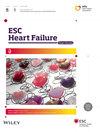Comprehensive exploration of unexplained dyspnoea in subjects with normal ejection fraction and low natriuretic peptides
Abstract
Background
Unexplained exertional dyspnoea without significant elevation of natriuretic peptides is common. One of the causes might be early heart failure with preserved ejection fraction (HFpEF).
Aims
This study aimed to characterize patients with exertional dyspnoea and normal/near-to-normal N-terminal pro-brain natriuretic peptide (NT-proBNP) levels with regard to early stages of HFpEF and non-cardiac causes.
Method and Results
Sixty-six patients (age 62 ± 7 years old, 85% women) with dyspnoea assessed using the Multidimensional Dyspnea Profile (MDP) questionnaire and NT-proBNP level of <125 pg/mL for patients <75 years old or <300 pg/mL for patients >75 years old were recruited. Patients with known significant heart disease, lung disease (abnormal respiratory function tests) or renal insufficiency stage ≥ 4 were excluded. In 11 patients (16.7%), HFpEF was confirmed according to the European Society of Cardiology Heart Failure Association (ESC HFA) criteria, 31 patients (47%) presented isolated deconditioning and 5 patients (7.6%) had idiopathic hyperventilation. In the remaining 19 patients (28.8%) with normal echocardiography and cardiopulmonary exercise testing (CPX), no objective cause of dyspnoea could be found. Compared with patients without HFpEF, those with HFpEF were older, more often hypertensive and diabetic, with higher NT-proBNP levels. They had higher E/e′ ratios during exercise echocardiography and lower volume of oxygen uptake (VO2) peaks and steeper minute ventilation (VE)/volume of carbon dioxide produced (VCO2) slopes during CPX. Psychological impact measured on the Short Form-36 (SF-36) questionnaire was less important in HFpEF patients than in other patients.
Conclusions
The most common causes of unexplained exertional dyspnoea in patients without significant elevation of natriuretic peptides are peripheral deconditioning, HFpEF and hyperventilation. Studying patients during exercise allows for getting more data about pathophysiology and improving patient phenotyping and management. Early unmasking of HFpEF using exercise echocardiography and/or CPX and initiation of treatment could prevent hospitalizations for acute heart failure. Although using exercise testing, many patients could not be classified according to their diagnosis, and this reinforces the need to better define exercise diagnostic criteria.


 求助内容:
求助内容: 应助结果提醒方式:
应助结果提醒方式:


